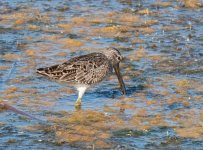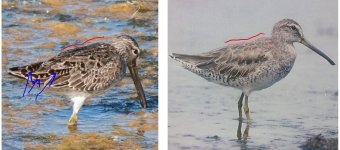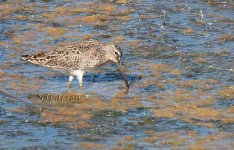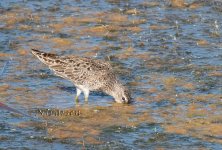Salt levels are not a good sole basis for ID but still helpful as a clue. This is a Short-billed Dowitcher, which is definitely the more common species in your location. The bill in the first photo is not within the range of Long billed. It’s short, thick, and heavily kinked at the tip. You can easily find examples of Short billed dowitchers with straight bills, but not Long billed with bills kinked such as this very typical appearance of Short billed.
While it is true that there is a lot of “guff” out there on these two species, there are very reliable cases where species can be identified and some people are genuinely very accurate with their identifications. I do not always know which species I am looking at, but when I see a good profile I have a very high success rate of proper identification. The complex is challenging and most of the “rules” only hold true in ideal cases. Nonetheless, there is some obvious merit to all of the commonly referenced ID traits when used carefully and with experience.
For example, I have recently seen it suggested on this forum that the “loral angle” field mark has been found to not be that helpful. This is not a good evaluation, but it is easy to understand how someone would arrive at that conclusion. It’s just a case by case measure, and in some photos the posture and viewing angle of the bird can render the field mark useless. You can however, learn to have a very accurate understanding of when those times are.
I personally do not ever expect to be able to identify all cases of dowitchers, and it is highly unlikely that I will ever get good enough at it to be correct 100% of the time, but I wouldn’t call the literature “guff”. There is a lot of useful information to be gleaned from the commonly proposed field marks, it just requires a deeper dive into how to use them effectively.









